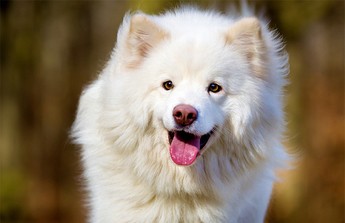The Samoyed’s thick double coat in white, white and biscuit, cream, or all biscuit stands out from the body as if surrounding the dog with a halo of hair. The undercoat, which is what protects the Sammy from the elements, is soft, short, thick and woolly. The outer coat is made up of harsh longer hair.
Brush the Samoyed’s coat at least once a week to prevent or remove mats and tangles and remove dead hairs that will otherwise wind up on your floor, furniture, and clothing. Expect to brush it daily during seasonal shedding periods. You’ll need a slicker brush, pin brush and metal Greyhound comb. Bathe the Sammie about every three months.
The rest is basic care. Check the dog's ears on a weekly basis for signs of infection, irritation, or wax build up. Cleanse regularly with a veterinarian-approved cleanser and cotton ball. Brush the teeth at least once per week to prevent tartar buildup and prevent gum disease. Additionally, nails should be trimmed once per month if the dog does not wear the toenails down naturally.
A working dog by nature and ancestry the Samoyed needs to be kept busy. Be sure that your Samoyed gets plenty of exercise, as it helps it stay healthy and happy and it helps relieve some of the pent up energy. The more energy it uses up, the less of the impact of separation anxiety and destructive habits. The Samoyed is quite strong, as it used to pull sleds and hunt polar bears, so be careful when playing with this breed.
The winter time is their favorite time of year, and you can be sure your Sammy will entertain himself for hours in the snow, especially if he has children to play with. Without snow, you'll want to walk your Samoyed several times a day and allow him to stretch his legs and run several times per week, especially as a puppy. If a Samoyed does not get enough exercise he will let you know by chewing your personal possessions.
With this said, Samoyed puppies should not be over exercised because their joints and bones are still growing. This includes not letting a dog jump up and down from furniture or going up or down the stairs. Too much pressure on their joints and spines at an early age could result in a dog developing problems later in their lives.
Samoyeds do well on a raw diet, which is no surprise, as its ancestors were used for hunting. Even if you go the dry dog food route, feel free to throw your dog some extra meat and even a real bone to chew on. As well, your Samoyed may enjoy raw fruits and vegetables.
If you get a Samoyed puppy from a breeder, they would give you a feeding schedule and it's important to stick to the same routine, feeding the same puppy food to avoid any tummy upsets. You can change a puppy's diet, but this needs to be done very gradually always making sure they don't develop any digestive upsets and if they do, it's best to put them back on their original diet and to discuss things with the vet before attempting to change it again.
Older dogs are not known to be fussy or finicky eaters, but this does not mean you can feed them a lower quality diet. It's best to feed a mature dog twice a day, once in the morning and then again in the evening, making sure it's good quality food that meets all their nutritional requirements. It's also important that dogs be given the right amount of exercise so they burn off any excess calories or they might gain too much weight which can lead to all sorts of health issues. Obesity can shorten a dog's life by several years so it's important to keep an eye on their waistline from the word go.
Samoyeds do well on a raw diet, which is no surprise, as its ancestors were used for hunting. Even if you go the dry dog food route, feel free to throw your dog some extra meat and even a real bone to chew on. As well, your Samoyed may enjoy raw fruits and vegetables.
The average life expectancy of the Samoyed is between 12 and 15 years. The most common health problems known to affect the Samoyeds includehip dysplasia, cataracts, glaucoma, and diabetes. Hip dysplasia affects the hips and can range in severity from moderate to severe pain. If left untreated, cataracts may lead to blindness, as will glaucoma, and diabetes is often known to reduce the lifespan of the Samoyed.
The Samoyede people lived in tents and huddled for warmth with their dogs on brutal Arctic nights. This unusual degree of dog-and-master closeness forged a tight bond between Sammies and humankind. A Sammy sentenced to solitary confinement in the backyard is a miserable—and destructive—creature. These are smart, social, mischievous dogs who demand love and attention. Sammies need a firm but loving hand in training.
And you must always make sure you keep the upper hand at all times during the training process. That way, your position as alpha is understood and unchallenged. Since it is a pack dog, the Samoyed will be happiest once it knows its position in the pack.
Start training your Samoyed early and your life with this dog will run a lot smoother. It’s also a great way to stop bad habits such as barking, chewing, jumping up, nipping, and grabbing onto objects.











